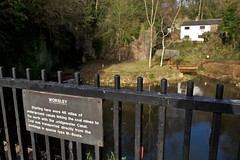Bridgewater Canal
Commemorated on 1 plaque
Worsley Starting here were 46 miles of underground canals linking the coal mines to the north with the Bridgewater Canal. Coal was transported directly from the workings in special type M-Boats.
Worsley Road, Worsley, United Kingdom where it was

